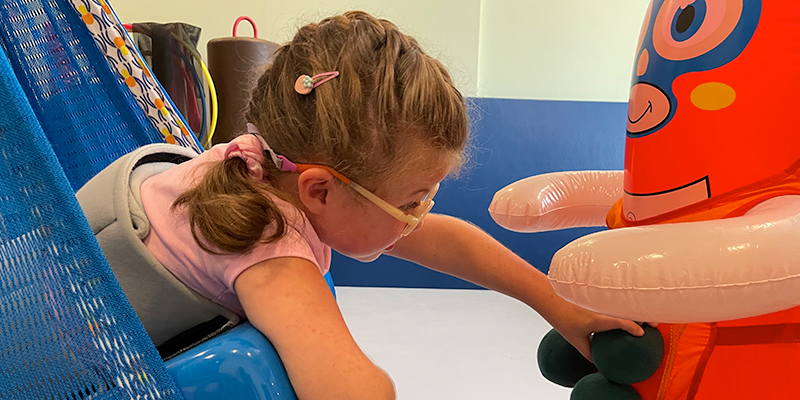

Proprioception: Our Sixth Sense

Kunali Doshi
DHA License Number: 00100771-002
Senior Pediatric Physical Therapist

Meaning of Proprioception
Have you ever walked into a dark room and searched for the light switch? The sensory systems your body relied on to navigate in that environment are collectively known as proprioception. Think about the sensory systems your body relies on to move in that situation.
Proprioception is a movement mediator. It helps structure and order what is unknown in the environment as you move. It guides us where to begin and where to end; it provides the body with awareness of space and stability to move and navigate. Self -generated proprioception comes from self-generated movements and is the most effective form.
Here are some examples from our daily lives where we use Proprioception
Example 1: Imagine that you have been sitting on an office chair for a long period and you begin feeling discomfort and heaviness on your bottom and shift your body weight without thinking.
Example 2: Balancing yourself on a divider when cars are speeding from both sides requires the body awareness to stay stable without swaying. All your senses are bombarded in this situation and the proprioceptive system is the one you rely on the most to keep stable.
Proprioception includes awareness of position and movement of our limbs and trunk, the awareness of resistance and force, and awareness of heaviness. It is the sixth sense of knowing where you are spatially without thinking about it. Proprioception allows you to walk without consciously thinking about where to place your foot next. It lets you touch your elbow with your eyes closed.
Why is proprioception important for our body?
The study of proprioception has always attracted widespread interest. Part of the reason is the important role played by proprioception in motor control. We are unable to move towards a target without ongoing visual and proprioceptive feedback. In addition, proprioception is appealing because it promises a better understanding of our everyday sensory experiences.
Proprioception helps with orientation of our body in space especially our head and neck.
It can be classified as conscious and unconscious proprioception. Conscious proprioception includes the sense of limb movement and static limb position in space. Unconscious proprioception arises from resting muscle tension and stretch. It is necessary for the maintenance of normal muscle tone and posture as well as coordinated and smooth movements.
As you speak, the tension in your neck, facial and jaw muscles attempt to make oral movements for consistent speech and the timing and length of the activity can be modulated by the person due to the awareness and proprioception received consciously and unconsciously.
The voice modulation, pitch and frequency of a whisper is so much different from a scream and this is possible only because of the proprioceptive awareness we receive from our tongue, jaw, palate, cheeks and other head and neck muscles.
Grading the force generation and speed of limb movement is an integral part of our coordination and control of body movements.
When you press a button on a controller you need to press it with enough force to make it work. It’s important to not press it too firmly as it might slide out of your hand or break. This is called grading your force. We do this all the time quite naturally and without thinking about it. Our proprioceptors are doing the thinking for us.
You also need to move the controller at the right speed to ensure you don’t crash your hand into yourself or into another person. That is your speed of limb movement. Your brain stores all this depth, speed and special awareness of movement in the neural pathways and recalls it every time we are exposed to the same movement pattern.
Now imagine walking down a train station and coming across a sudden change in depth of one step out of the many. Your brain is wired to anticipate the same height and depth of the steps and an odd one out there can perturb your balance and disrupt your orientation.
If we use too much force or speed, we could break things. If we use too little, we might not be successful. When hammering a nail, for example, striking too hard may bend the nail, but striking too softly will not drive the nail in. The same is true with cracking an egg: if you tap too lightly it won’t open, but if you crack it too quickly or with too much force you will end up having to clean up a mess!
Our spatial orientation, anticipation before movement and postural counterbalance all emanate from resting muscle tone. Muscle tone refers to the constant partial contraction our muscles are making when we are still. It allows our bodies to increase or decrease tension as required when moving. Our proprioceptive system helps our vestibular/movement system to support this tension. Some children with sensory processing disorders may have lower muscle tone which can affect their postural control and stability.
Finally, our proprioceptive sense helps to support our balance. It again works with our vestibular and visual system which is primarily responsible for balance. Our proprioceptors give our brain even more information about where our body is, and this helps with our balance. For example, if you step on an unstable surface, you receive vestibular information from your inner ear about the change in head position and you receive proprioceptive information about the position that your ankle, knee, and hip are in. The combination of this information helps your body keep upright and not fall over.
How does our body process Proprioception?
Proprioception comes from sensory nerve endings that provide our brain with feedback on limb position. There are special nerves in your muscles and joints that directly communicate with your brain the position of your joint and how much stretch or strain there is on the muscles surrounding it. The nerves surround each muscle bundle, creating a system of communication with your brain about what is happening to the muscles and joints of your body.
On that basis, if a movement goes to plan and there is no mismatch between the expected signals and those generated, no definable sensation is produced, yet the subject knows precisely the location of their limb. Motor output is highly influenced by the proprioceptive system. There are times when our body relies on other sensory systems like visual and auditory systems to compensate for the lack of proprioception.
When the child is exposed to a new environment or a change in setting with furniture moved around, they feel lost and must recalibrate their orientation to the changes.
At times of growth spurts the child’s receptors must reorganize to the biomechanical changes in the body alignment in order to send accurate information to the brain and feel safe and well oriented in their own bodies.
Signs that your child has difficulties with proprioception:
- Moves fast, can appear clumsy
- Bites, pushes, scratches, bumps, bangs
- Exhibits floppy posture
- May tighten up or fix
- Appear uncoordinated and have difficulty with large motor skills such as jumping, climbing, or bike riding
- Weak hand grasp and poor handwriting skills
- Like to chew on their fingers, clothes, pens, toys, or hard objects
- Poor Postural Control (slumps, unable to stand on one foot, needs to rest head on desk while working)
- Engaging in behaviours such as toe walking, crashing, running or flapping arms
- Cries in weight bearing positions
- Problems with anticipation
- Trouble maintaining postural stability (unable to stand on one foot, slumping at their table, must support head with their hands)
- Difficulty finding the right level of pressure for the movement, (for example pushing too hard when using pencil and snapping it, not gripping bottle hard enough and dropping it)
- Difficulty planning or carrying out tasks (unable to finish task as cannot direct limbs to make the movement)
How do we work on proprioception in our kids during Therapy?
Providing proprioception and activating the proprioceptive system in the child is like preparing the child for movement. Bouncing on a ball, transitions like rising to sit from lying down, pushing up on arms in prone, crawling, crashing, jumping, squeezing, and carrying weighted balls are all activities that provide proprioceptive input to increase the child’s body awareness and allow them to know where their body is in space. Sustained firm pressure or sustained active joint compression provides feedback about one’s position in space.
Several therapy tools like the Spider Cage, TheraTogs, Kinesiotaping, lycra swings, Bosu, scooter board activities, balls, platform swings, wobble board, inclined surfaces, TheraBand or resistive tubes and weighted toys can help work on the proprioceptive system to gain most benefits from the movement and postural muscles. Every child’s need for proprioceptive input is met by combining different tools from the list mentioned above suited to their strengths and weaknesses.
Coupling the proprioceptive system along with the vestibular system and visual system can provide the child with readiness and anticipation in the body to generate movements. This also works on the child’s arousal level and ability to regulate his/her emotional state appropriate to the demands of the task during therapy sessions.
Although children may receive this input in therapy, they will get better results with follow through at home.
Here are a few activities that you can include at home to provide proprioceptive input:
- Household chores—vacuuming, carrying filled laundry baskets/detergent, carrying groceries, sweeping
- Trampoline
- Climbing a ladder
- Catch and throw with a weighted ball
- Resistive walking against pull of an elastic band
- Bear hugs
- Wall pushes
- Dressing skills like donning and doffing of socks and shoes
- Movements like squatting, sit to stand, climbing uphill
- Walking in water or on beach
- Squeezing out water from a sponge
- Playing tug of war
- Play dough or Thera putty play
- Walking on the beach/pool
It is possible to generate an artificial proprioceptive signal using muscle vibration such as the whole-body vibration on the Galileo platform. Vibration produces sensations of limb displacement and movement, leading the child to express astonishment at the unwilled nature of the sensations. This suggests that the will to move and the subsequent proprioceptive sensations are intimately linked.
Try to think about the examples mentioned in this post to better understand your sixth sense. If you have questions about your child’s proprioceptive system or muscle tone, please reach out to our Physical Therapy team who will be able to help you better understand your child’s needs.
Sources:
- https://pubmed.ncbi.nlm.nih.gov/23073629/
- Neuro-Developmental Treatment- A Guide to NDT Clinical Practice, Cerebral Palsy, Marcia Stamer. PT, MH, C/NDT, 2016


